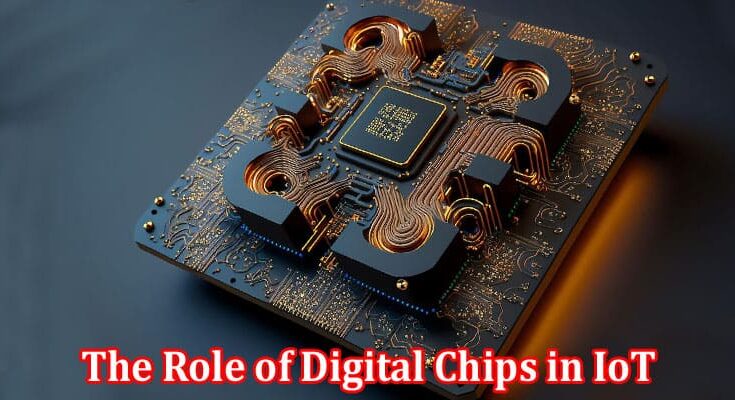Digital chips, often referred to as microchips or integrated circuits, are at the core of virtually all electronic devices. These chips are constructed using semiconductor materials and are designed to perform various functions. In the context of IoT, digital chips serve as the brain of the connected devices. They are responsible for processing data, executing commands, and facilitating communication with other devices or the central IoT platform.
In this blog, we will delve into the significance of digital chips in IoT, and their impact on various industries.
Digital chips are the enablers of IoT, playing several critical roles:
1. Data Processing:
Digital chips process the data collected by sensors in IoT devices. They can analyze data in real time, extract meaningful information, and make decisions based on predefined algorithms. This processing capability is crucial for applications like autonomous vehicles, where split-second decisions can be a matter of life or death.
2. Connectivity:
Wireless chips within IoT devices establish connections to the internet or other devices. They facilitate the transfer of data to central servers or other connected devices. This connectivity is essential for remote monitoring and control, which is a hallmark of IoT.
3. Power Management:
Many IoT devices are battery-powered and require efficient power management to ensure long-lasting operation. Digital chips, especially MCUs and low-power SoCs, are designed to minimize power consumption, extending the device’s battery life.
4. Security:
IoT security is a paramount concern, and digital chips play a role in safeguarding data and communication. They can incorporate encryption, authentication, and secure boot mechanisms to protect against unauthorized access and data breaches.
5. Adaptability:
Some IoT applications require the ability to adapt to changing conditions or requirements. FPGAs and reprogrammable SoCs offer the flexibility to update the device’s functionality without physical changes, making them suitable for such scenarios.
6. Scalability:
IoT ecosystems often involve a multitude of devices. Digital chips can be integrated into a wide range of devices, from tiny sensors to industrial machinery, ensuring that IoT solutions are scalable and can cater to diverse use cases.
Impact on Industries
The integration of digital chips in IoT has revolutionized several industries. Here’s a glimpse of how different sectors benefit from this technology:
- Smart Home Automation: In the realm of smart homes, digital chips are found in devices like thermostats, cameras, and voice-activated assistants. These chips enable remote control and automation, enhancing convenience and energy efficiency.
- Healthcare: Wearable devices with digital chips have become integral in healthcare. These devices can monitor vital signs, track physical activity, and even provide real-time health data to medical professionals, leading to better patient care and early disease detection.
- Agriculture: IoT and digital chips have made significant inroads in agriculture through precision farming. Sensors and digital chips monitor soil conditions, weather, and crop health, allowing farmers to optimize irrigation and resource allocation.
- Industrial IoT (IIoT): The industrial sector has witnessed a substantial transformation through IIoT. Digital chips are incorporated into machines and equipment to enable predictive maintenance, monitor performance, and enhance overall efficiency.
- Logistics and Supply Chain: In logistics, digital chips are used for asset tracking and supply chain management. They enable real-time monitoring of the location and condition of goods, reducing losses and improving overall supply chain efficiency.
- Smart Cities: The concept of smart cities relies on IoT and digital chips for managing traffic, reducing energy consumption, and enhancing public services. These chips help collect and analyze data from various sensors and devices deployed across the city.
- Environmental Monitoring: IoT and digital chips are essential in environmental monitoring applications. They help collect data on air quality, water quality, and weather conditions, aiding in environmental conservation and disaster prevention efforts.
The Future of Digital Chips in IoT
The role of digital chips in IoT is poised to expand further in the coming years. As technology advances, we can expect more powerful, energy-efficient, and secure chips that will enable even more sophisticated IoT applications. Moreover, the integration of artificial intelligence through electronic parts supplier and machine learning into IoT devices will rely heavily on advanced digital chips to process and analyze data at the edge, reducing the need for constant data transmission to the cloud.
End Note
Digital chips are the unsung heroes of the IoT revolution. They are the invisible yet indispensable components that power the connectivity, intelligence, and innovation that IoT promises. As IoT continues to grow and diversify, digital chips will continue to evolve, shaping the future of technology and transforming the way we live and work. It is safe to say that we are only beginning to scratch the surface of what digital chips can do in the Internet of Things.
FAQs
1. Is IoT a digital tool?
Yes, IoT is a digital tool that connects physical objects to the internet, allowing them to collect and share data.
2. What is an example of SoC in IoT?
The Raspberry Pi is an example of an SoC that is commonly used in IoT devices.
3. What is the forecast for IoT semiconductors?
The global IoT semiconductor market is expected to reach $196.1 billion by 2028, growing at a CAGR of 12.7% from 2023 to 2028.
4. What is IoT hardware devices?
IoT hardware devices are physical objects that are equipped with sensors, actuators, and other components that allow them to connect to the internet and collect and share data. Examples of IoT hardware devices include smart thermostats, smart cameras, and wearable devices.

Caroline is a dedicated writer with a passion for keeping readers informed. Specializing in providing the latest news updates and unbiased reviews, she strives to deliver accurate and insightful content. With a keen eye for detail and a commitment to journalistic integrity, Caroline ensures that her readers are always well-informed. Stay tuned for her latest articles to stay up-to-date on current events and trends.




